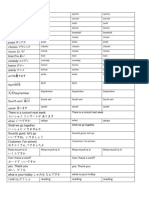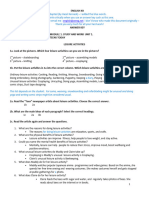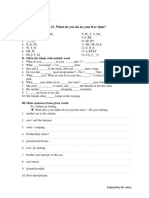TOPIC 17 Enjoying Free Time
TOPIC 17
Enjoying Free Time
(Session 1- Module 1)
P a g e 1 | 10
� TOPIC 17 Enjoying Free Time
TOPIC 17 : ENJOYING FREE TIME Session
1
Greetings にほんごじん の みなさん! How are you? I hope
you are having fun while learning Nihongo! Having
experienced the traditional Bon Odori Dance in Topic16 must
have been challenging wasn’t it?
In this module, you will get to know how Japanese high
school students spend their free time and also learn useful
expressions for asking someone about his/her weekend
activities.
Learning Engagement:
Take a look at these activities below, which of these do you happen to do
during your free time?
Draw a checkmark right next to the picture of the activities that you engage in.
Surfing the internet Reading books Listening to music
Do you do
something else?
What is it?
________________
________________
________________
Watching TV shows Playing with friends ________________
What about your friends? Do you know what they do during their Free Time?
Do you do similar activities?
Let us know what you think!
___________________________________________________________________
___________________________________________________________________
P a g e 2 | 10
� TOPIC 17 Enjoying Free Time
WAY TO GO! がんばりました!
As you already know, Topic 17 is “Enjoying Free Time.” We will compare how different
people spend their free time now and how they spent it during their childhood.
In this session, we are going to:
know how Japanese junior high school students spend their free time
learn how to say the names of various free time activities in Japanese.
Let’s continue!
Learning Engagement:
Earlier, you were asked if you think your friends do the same activities as you do during
their free time. In this activity, write down on the table below a few activities that you
think Japanese junior high school students do during free time.
Table 1: Activities that I think Japanese students do during their free time
ACTIVITY 1: Match column A with Column B
Guess the meaning of the Nihongo terms given in Column A by matching it with the
English terms in Column B.
Table 2: Matching English with Nihongo Terms
にほんご ENGLISH
べんきょう する Play with Friends
テレビ を みる Go shopping
ほん を よむ Watch a movie
まんが を よむ Play Sports
ゲーム を する Surf the Internet
インターネットを する Play Games
スポーツ を する Read Manga
えいが を みる Read a Book
かいもの に いく Watch the Television
ともだち と あそぶ Study
P a g e 3 | 10
� TOPIC 17 Enjoying Free Time
Let’s talk about it!
How do you find the activity? Was it easy to guess the meaning of the Nihongo terms
in column A? Try to compare your answers to the activity with this table.
Table 3: Answers to Activity 1
にほんご ENGLISH
べんきょう する Study
テレビ を みる Watch the Television
ほん を よむ Read a Book
まんが を よむ Read Manga
ゲーム を する Play Games
インターネットを する Surf the Internet
スポーツ を する Play Sports
えいが を みる Watch a Movie
かいもの に いく Go Shopping
ともだち と あそぶ Play with Friends
The activities written in table 3 above are also what Japanese junior high school
students do during their free time.
What have you observed after comparing your answers in Table 1 to the
reference given above? Are you familiar with these activities? Do Japanese and
Filipino students spend their free time similarly?
___________________________________________________________________
___________________________________________________________________
___________________________________________________________________
P a g e 4 | 10
� TOPIC 17 Enjoying Free Time
VOCABULARY BUILDING
In this part, you will identify the most popular up to the
least popular activities Japanese junior high school students do
during their free time using a survey ranking result.
Follow the activities below to find out! がんばって ください!
Learning Engagement:
List down under each column respectively, the top 3 activities which you think
Japanese high school boys and girls do during their free time.
Table 4: Guess on Top 3 Activities
JAPANESE BOYS JAPANESE GIRLS
Top 1 Top 1
Top 2 Top 2
Top 3 Top 3
ACTIVITY 2: Arrange the rank of activities by guessing its popularity
Given below are the actual activities that Japanese boys and girls do during their free
time in random order.
Top 10 Activities for Boys Top 10 Activities for Girls
Go to Juku Go to Juku
Play sports Play Games
Read Books Listen to Music
Study Study
Watch Television Watch Television
Play with Friends Play with Friends
Read Manga Read Manga
Listen to Music Read Books
Surf the internet Surf the internet
Play Games Play sports
Your task is to figure out the ranking of the activities by writing the correct order on the
table.
To practice writing the Nihongo expressions in hiragana, the actual choices are given
in English but you should write its Nihongo equivalent on the answer-sheet table below.
P a g e 5 | 10
� TOPIC 17 Enjoying Free Time
Table 5: Answer sheet for Activity 2
TOP 10 Activities TOP 10 Activities
JAPANESE BOYS JAPANESE GIRLS
Top 1 Top 1
Top 2 Top 2
Top 3 Top 3
Top 4 Top 4
Top 5 Top 5
Top 6 Top 6
Top 7 Top 7
Top 8 Top 8
Top 9 Top 9
Top 10 じゅく に いく Top 10 じゅく に いく
Let’s talk about it!
How do you find the activity? Was it difficult figuring out the most popular activity
among the given choices? Do your rankings vary from boys to girls? How did you
decide the ranking? Let us know your thoughts!
__________________________________________________________________
__________________________________________________________________
__________________________________________________________________
After so, try to compare your answers to the activity with this table.
Table 6: Top 10 Activities Japanese Boys and Girls do during their free time
TOP 10 Activities TOP 10 Activities
JAPANESE BOYS JAPANESE GIRLS
Top 1 ともだち と あそぶ Top 1 ともだち と あそぶ
Top 2 テレビ を みる Top 2 テレビ を みる
Top 3 ゲーム を する Top 3 おんがく を きく
Top 4 スポーツ を する Top 4 まんが を よむ
Top 5 まんが を よむ Top 5 インターネット を する
Top 6 おんがく を きく Top 6 ほん を よむ
Top 7 インターネット を する Top 7 スポーツ を する
Top 8 べんきょう する Top 8 べんきょう する
Top 9 ほん を よむ Top 9 ゲーム を する
Top 10 じゅく に いく Top 10 じゅく に いく
P a g e 6 | 10
� TOPIC 17 Enjoying Free Time
FOLLOW UP QUESTIONS:
1. Did your guess closely match the actual rank?
___________________________________________________________
2. How do you find the preferences between boys and girls? Did it vary?
___________________________________________________________
“Juku ni iku”
Anything else bothers you?
“じゅく” is a cram school or better known
Here is for extra information! as a private tutorial school where
elementary and high school students go
after school hours or during weekends
which offers supplementary classes for
better academic performance of students.
YOU DID WELL! がんばりました!
Now it’s time for a quick review! Look at each picture below, a few information related
to the pictures are already given, fill out the missing information by following the
example in number 1.
1. 2..
まんが を よむ ____________
Manga o yomu Ge-mu o suru .
Read manga _____________________
P a g e 7 | 10
� TOPIC 17 Enjoying Free Time
インターネット を する ____________
____________ Terebi o miru________
____________ ____________
____________ ____________
____________ スポーツ を する .
Play Games . ______________________
____________ . ほん を よむ
Tomodachi to asobu _____________________
_____________________. _____________________
_____________________.
P a g e 8 | 10
� TOPIC 17 Enjoying Free Time
NIHONGO PRACTICE
In this part, you’ll be able to share/ practice speaking
how you spend your free time.
Learning Engagement:
Using the table below, write down the activities that you usually do during your free
time. The sample table will have more tabs but you are to write the top 3 activities you
do on a specific day. The next tabs will be used in the next module.
TABLE 7: Top 3 activities I do during my free time
If you want to say other things which you haven’t
learned yet in Japanese, try using “(The gerund/
verb+ing) o suru”, for example “cooking o suru”,
“cleaning o suru”, etc.
ACTIVITY 3: SELF RECORDING
Normally, after learning a few Nihongo expressions, you will have to do
conversation practice with your classmates. In this module instead, try
recording yourself while reading or saying the Nihongo expressions your learned
today. You may also use the Top 3 activities you listed above.
Kindly refer to a few hints and suggestions given below to guide with this activity.
Procedure:
P a g e 9 | 10
� TOPIC 17 Enjoying Free Time
1. Create a script highlighting the Nihongo expressions you learned in this
session. It doesn’t matter if it’s just short. Also, don’t feel awkward to mix
English terms in your script.
Example:
From Mondays to Fridays, watashi wa benkyou suru. During Saturdays,
watashiwa wa kaimono ni iku. Soreto, terebi o miru.
In this example, the speaker wanted to say more than
2 activities, so he/she can use “soreto” between
sentences.
(Ex. Shopping ni iku. Soreto, terebi o miru.)
2. After drafting your script, try to practice it without reading so that you will
sound more natural in the recording.
3. If you have a mobile phone with a camera, it is best to use the video recorder
so that you can also practice your posture while speaking. If you only have a
voice recorder available, still try not to read your script.
4. Recording your voice may not be as easy as it sounds because listening to
our recordings may feel odd. Try to be more objective when listening to your
recording. Check for pronunciation and /or possible awkward pauses or
accent.
5. Once you are happy with the recording you may continue with writing your
reflection for this module.
がんばって ください!
ふりかえり
Reflection
How was your experience learning TOPIC 17 Session 1? Let us know how you feel!
___________________________________________________________________
________________________________________________
Objectives
know how Japanese junior high school students spend their free time
learn how to say the names of various free time activities in Japanese.
P a g e 10 | 10





















































































